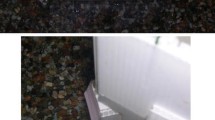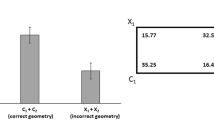Summary
The performance of the blind cave fish in discriminating spatial intervals was investigated. The fish had to discriminate between pairs of grids consisting of equidistant vertical bars. The intervals between the bars on the grid to be chosen were kept constant while the intervals between the bars on the other grid were altered in steps so as to become gradually closer to the interval between the bars on the grid to be chosen. It was found that the fish were still able to discriminate between the two grids when the difference between the bar intervals amounted to at least 1.5 mm. In interpreting the results it was concluded that the phase information in the stimulus on the skin of the fish must be significant for it.
Similar content being viewed by others
Abbreviations
- LLO :
-
lateral line organ
- SDP :
-
spatial discriminatory performance
- SDPF :
-
spatial discriminatory performance factor
- TDPF :
-
temporal discriminatory performance factor
References
Bleckmann H (1980) Reaction time and stimulus frequency in prey localization in the surface-feeding fishAplocheilus lineatus. J Comp Physiol 140:163–172
Bleckmann H, Schwartz E (1982) The functional significance of frequency modulation within a wave train for prey localization in the surface-feeding fishAplocheilus lineatus (Cyprinodontidae). J Comp Physiol 145:331–339
Bleckmann H, Waldner I, Schwartz E (1981) Frequency discrimination of the surface-feeding fishAplocheilus lineatus — A prerequisite for prey localization? J Comp Physiol 143:485–490
Campenhausen C von, Riess I, Weissert R (1981) Detection of stationary objects by the blind cave fishAnoptichthys jordani (Characidae). J Comp Physiol 143:369–374
Dijkgraaf S (1952) Bau und Funktionen der Seitenorgane und des Ohrlabyrinths bei Fischen. Experientia 8:205–216
Dijkgraaf S (1962) The functioning and significance of the lateral-line organs. Biol Rev 38:51–105
Flock A, Wersäll J (1962) A study of the orientation of the sensory hairs of cells in the lateral line organ of fish, with special reference to the function of the receptors. J Cell Biol 15:19–27
Frühbeis B (1984) Verhaltensphysiologische Untersuchungen zur Frequenzunterscheidung und Empfindlichkeit durch das Seitenlinienorgan des blinden HöhlenfischesAnoptichthys jordani (Hubbs et Innes). Dissertation, Universität Mainz
Görner P (1961) Beitrag zum Bau und zur Arbeitsweise des Seitenorgans vonXenopus laevis. Verh Dtsch Zool Ges pp 193–198
Harris GG, van Bergeijk WA (1962) Evidence that the lateral line organ responds to near-field displacements of sound sources in water. J Acoust Soc Am 34:1831–1841
Hassan El-S (1985) Mathematical analysis of the stimulus for the lateral line organ. Biol Cybern 52:23–36
Hoin-Radkovski I, Bleckmann H, Schwartz E (1984) Determination of source distance in the surface-feeding fish,Pantodon buchholzi (Pantodontidae). Anim Behav 32:840–851
Kuiper JW (1967) Frequency characteristics and functional significance of the lateral line organ. In: Cahn P (ed) Lateral line detectors. Indiana University Press, Bloomington London, pp 105–121
Maler L, Karten HJ, Bennett MVL (1973) The central connections of the posterior lateral line nerve ofGnathonemus petersii. J Comp Neurol 151:57–66
Maler L, Finger T, Karten HJ (1974) Differential projection of ordinary lateral line receptors and electroreceptors in the gymnotid fishApteronotus (Sternarchus) albifrons. J Comp Neurol 135:315–325
Münz H, Claas B (1983) The functional organization of neuromasts in the lateral-line system of a cichlid fish. Adv Vertebrate Neuroethology, Ser A 56:301–307
Plassmann W (1980) Central neuronal pathways in the lateral line system ofXenopus laevis. J Comp Physiol 136:203–213
Schemmel C (1967) Vergleichende Untersuchungen an den Hautsinnesorganen ober- und unterirdisch lebenderAstyanax-Formen. Z Morphol Tiere 61:255–316
Schwartz E (1965) Bau und Funktion der Seitenlinie des Streifenhechtlings (Aplocheilus lineatus). Z Vergl Physiol 50:55–87
Schwartz E (1971) Die Ortung von Wasserwellen durch Oberflächenfische. Z Vergl Physiol 74:64–80
Skudrzyk E (1971) The foundation of acoustics. Springer, Wien New York, pp 346 ff
Teyke T (1985) Collision with and avoidance of obstacles by blind cave fishAnoptichthys jordani (Characidae). J Comp Physiol A 157:837–843
Weissert R, Campenhausen C von (1981) Discrimination between stationary objects by the blind cave fishAnoptichthys jordani (Characidae). J Comp Physiol 143:375–381
Author information
Authors and Affiliations
Rights and permissions
About this article
Cite this article
Hassan, E.S. On the discrimination of spatial intervals by the blind cave fish (Anoptichthys jordani). J. Comp. Physiol. 159, 701–710 (1986). https://doi.org/10.1007/BF00612042
Accepted:
Issue Date:
DOI: https://doi.org/10.1007/BF00612042




